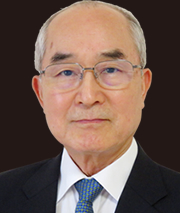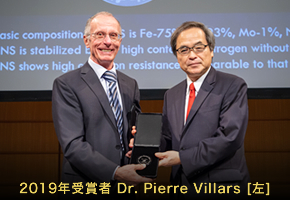2020 Award Winners

- Research field
- Thermoelectric Energy Conversion
- Research achievement title
- Pioneer work on bismuth telluride thermoelectric material and its application for large-capacity optical communication systems using the Peltier cooling phenomenon
- Research summary
- Prof. H. J. Goldsmid identified bismuth telluride as a practical material for Peltier cooling for the first time in the world in 1954. Bismuth telluride is still the preferred thermoelectric material for application to Peltier devices to make progress in large-capacity long-haul optical communication worldwide. In addition, he validated the existence of a bipolar component in thermal conductivity in 1958. His observation of the phonon-drag phenomenon and experiments with the thermomagnetic effect in 1959 were one of the first trials in the world. He has achieved much excellent academic performance on boundary scattering of phonons, thermal conduction and thermoelectric energy conversion to contribute to the foundation and advancement of thermoelectric physics and technologies.
- Impact on the academic and industrial sectors
- Bismuth telluride is still the preferred thermoelectric material with high energy conversion efficiency near room temperature. The identification by Prof. H. J. Goldsmid was a good opportunity to promote drastic improvement of thermoelectric cooling technologies. As mentioned above, he has many research achievements on experimental physics focusing on phonon conduction, thermal conduction and thermoelectric phenomena. These excellent achievements laid the foundation for the science and technology of thermoelectric energy conversion and substantially contributed to technological progress and development of devices. Also his research achievements significantly contributed to the formulation of the basic grounds for IoT society and therefore Society 5.0 through the actualization of large capacity which is more than three orders of magnitude larger than conventional ones and long-haul transmission of optical communication.

Prof. Kunihito Koumoto
Profile- Research field
- Inorganic Materials Science
- Research achievement title
- Development of environmental-friendly inorganic thermoelectric materials
- Research summary
- Led the world firstly by focusing on developing high-performance thermoelectric materials based on environmental-friendly materials such as oxides and sulfides. He then proposed the idea that high-performance thermoelectrics can be realized by creating periodic structures based on different nanoblocks, thereby reducing thermal conductivity while preserving electrical conductivity. Such principles were applied to SrTiO3, which typically had low thermoelectric performance, to achieve a room temperature ZT=2.4. This principle was further applied to an inorganic/organic superlattice (TiS2/Hexylamine) to achieve ZT=0.32 at room temperature to 100oC. ZT=0.32 is equal to the best in the world as a flexible thermoelectric device.
- Impact on the academic and industrial sectors
- In contrast to conventional thermoelectric materials, which generally contain toxic and rare elements, he found the importance of and potential for high performance of environmental-friendly materials and led the paradigm shift in the development of thermoelectric materials. Previously only low-performance organic materials had been studied as flexible thermoelectric materials. However, he achieved innovative research results by fabricating hybrid superlattice structures by intercalating organic materials into the van der Waals gap of layered sulfides, thereby developing flexible high-performance inorganic/organic hybrid thermoelectric materials. Furthermore, by developing such high-performance nanostructured thermoelectric materials, he accelerated applicative research toward IoT energy harvesting and contributed largely to the development of environmental-friendly thermoelectric materials expected to be used by industry.
Past Winners
- 2019
-
Prof. Gerbrand Ceder (UC Berkeley, USA)
“Pioneering data-driven materials research based on the first-principles calculations”Dr. Pierre Villars (Materials Phases Data System (MPDS), Switzerland)
“Development of Pauling File, inorganic materials database” - 2018
-
Dr. Masato Sagawa (Daido Steel Co., Ltd., Japan)
“Invention and practical application of neodymium magnets”Prof. Terunobu Miyazaki (Tohoku University, Japan)
“Development of tunneling magnetoresistance elements capable of generating giant magnetoresistance at room temperature and application thereof to spintronics devices” - 2017
-
Prof. John Ågren (Royal Institute of Technology, Sweden)
“Development of kinetic simulation packages for computational thermodynamics"Prof. Bo Sundman (Royal Institute of Technology, Sweden)
“Development of kinetic simulation packages for computational thermodynamics"Prof. Kiyohito Ishida (Tohoku University, Japan)
“Alloy design and development of structural materials based on thermodynamics of phase diagrams and microstructure " - 2016
-
Dr. Koichi Mizushima (Toshiba Research Consulting Co. Ltd., Japan)
Dr. Akira Yoshino (Asahi Kasei Corp., Japan)
"Discovery of a suitable anode material for the lithium-ion battery (LiCoO2)" - 2015
-
Prof. Harald Rose (University of Ulm, Germany)
Prof. Maximilian Haider (KIT, CEOS GmbH, Germany)
Prof. Knut Wolf Urban (Research Centre Juelich, Germany)
“Theoretical study, development and popularization of the aberration corrector for electron microscopes, and its application to materials science "
